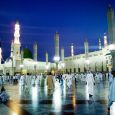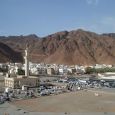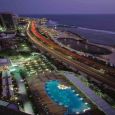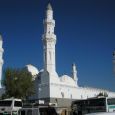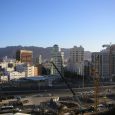Medina
Advertisement
By Air
The city is served by the Prince Mohammad Bin Abdulaziz Airport which opened in 1974.It handles on average 20–25 flights a day, although this number triples during the Hajj season and school holidays and the airport is accessible to non-Muslims.
By bus
The Saudi Arabian Public Transport Company (SAPTCO) runs to and from luxurious buses several times daily from most parts of the country at cheap rates.There are also privately run buses.The SAPTCO terminal is off-limits to non-Muslims.
Quba Mosque
is the oldest mosque in the world. Its first stones were positioned by the Islamic prophet Muhammad on his emigration from the city of Mecca to Medina and the mosque was completed by his companions. Muhammad spent more than 20 nights in this mosque (after migrating) praying qasr (a short prayer) while waiting for Ali whose house was behind this mosque.According to Islamic tradition, offering two rakaat of nafi prayers in the Quba Mosque is equal to performing one Umrah. Quba Masjid is the first mosque built in the history of Islam and was built as soon as Muhammad arrived on the Hijra.Muhammad used to go there, riding or on foot, every Saturday and offer a two rakah prayer.He advised others to do the same, saying, "Whoever makes ablutions at home and then goes and prays in the Mosque of Quba, he will have a reward like that of an 'Umrah." This hadith is reported by Ahmad ibn Hanbal, Al-Nasai, Ibn Majah and Hakim al-Nishaburi.The prayer hall is arranged around a central courtyard, characterised by six large domes resting on clustered columns. A portico, which is two bays in depth, borders the courtyard on the east and west, while a one-bayed portico borders it on the north, and separates it from the women's prayer area.The women's prayer area, which is surrounded by a screen, is divided into two parts as a passageway connects the northern entrance with the courtyard.
Mount Uhud
is a mountain in north of Medina.It is 1,077 m (3,533 ft) high.It was the site of the second battle between Muslim and Meccan forces.The Battle of Uhud was fought on 19 March, 625, between a force from the small Muslim community of Medina, in what is now north-western Arabia and a force from Mecca.Whilst heavily outnumbered, the Muslims gained the early initiative and forced the Meccan lines back thus leaving much of the Meccan camp unprotected.When the battle looked to be only one step far from a decisive Muslim victory a serious mistake was committed by a part of the Muslim army which shifted the outcome of the battle.A breach of Muhammad's orders by the Muslim archers who left their assigned posts to despoil the Meccan camp, allowed a surprise attack from the Meccan cavalry led by Meccan war veteran Khalid ibn al-Walid, which brought chaos to the Muslim ranks.Many Muslims were killed including Hamza ibn Abd al-Muttalib, the Prophet's uncle and foster brother.Muhammad himself was almost killed and came out badly injured.The Muslims had to withdraw up the slopes of Uhud.The Meccans did not pursue the Muslims further but marched back to Mecca declaring victory.
Masjid al-Qiblatain Mosque
is a mosque in Medina that is historically important for Muslims as the place where the Islamic prophet Muhammad, leading the prayer, is said to have been commanded to change the direction of prayer (qibla) from Jerusalem to Mecca.Thus it uniquely contained two prayer niches (mihrabs). Recently the mosque was renovated, removing the old prayer niche facing Jerusalem and leaving the one facing Mecca.The Qiblatain Mosque is among the three earliest mosques in Islam's history, along with Quba Mosque and Al-Masjid al-Nabawi.The name of the mosque goes back to the beginning of Islam when the companions of Muhammad named it after an event that took place. Muhammad was leading the prayer when he received a revelation from Allah instructing him to take the Kaaba as the Qiblah. According to traditional accounts, Muhammad, who had been facing Jerusalem during the prayer, upon receiving this revelation, immediately turned around to face Mecca, and those praying behind him also did so.After this, the mosque in which this incident occurred came to be known as Masjid al-Qiblatain (i.e. 'Mosque of the Two Qiblas').Many pilgrims who go to Mecca for hajj often visit Medina where some end up visiting the notable Qiblatain because of its historic signficance.
Mosque of the Prophet
is a mosque situated in the city of Medina.As the final resting place of the Islamic prophet Muhammad, it is considered the second holiest site in Islam by Muslims (the first being the Masjid al-Haram in Mecca) and is one of the largest mosques in the world.The mosque is under the control of the Custodian of the Two Holy Mosques.It is the second mosque built in history.One of the most notable features of the site is the Green Dome over the center of the mosque, where the tomb of Muhammad is located.It is not exactly known when the green dome was constructed but manuscripts dating to the early 12th century describe the dome.It is known as the Dome of the Prophet or the Green Dome.Subsequent Islamic rulers greatly expanded and decorated it.Early Muslim leaders Abu Bakr and Umar are buried in an adjacent area in the mosque.The site was originally Muhammad's house; he settled there after his Hijra (emigration) to Medina, later building a mosque on the grounds.He himself shared in the heavy work of construction.The original mosque was an open-air building.The basic plan of the building has been adopted in the building of other mosques throughout the world.
Tomb of Muhammad
Muhammad's grave lies within the confines of what used to be his wife Aisha's and his house. During his lifetime it was adjoining the mosque.The mosque was expanded during the reign of Caliph al-Walid I to include his tomb.The prophet's grave is an important reason for the particularly high sanctity of the mosque.Millions of visitors come to visit it every year because it is tradition to visit mosque when going on the pilgrimage to Mecca.Muhammad is buried next to the first two caliphs, Abu Bakr and Umar.Umar was gifted a spot next to Muhammad by his wife Ayesha, which had originally been intended for her.There is an empty grave within the tomb area meant for Jesus upon his return as the Messiah.Muhammad's grave itself cannot be seen as the area is cordoned off by a gold mesh and black curtains.As per Wahhabi tradition, the grave itself is not embellished or decorated and is two cubits high.The grave is marked by an austere green wooden dome above it, built by the Ottoman Turks.This dome has become universally emblematic of both the Muhammad himself as well as his beloved city of Medina.
Information not available


